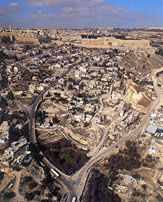
 |
|
|
|
|
|
|
|
|
|
|
|
|
|
| Home > History of Research > Tale of excavations > The City of David > Under Israeli Rule |
 |
Excavations in the City of David Under Israeli Rule
Eleven years had passed between the unification of the city under Israeli rule following the Six Days War (1967) and the beginning of excavations of the Shiloh Expedition (1978). The earliest full scale archaeological activities in Jerusalem just after the war were centered in other locations: B. Mazar excavated near the Temple Mount (1968-1978); N. Avigad excavated in the Jewish Quarter (1969-1982); and small-sized rescue excavations were being conducted by archaeologists working on behalf of the Israel Department of Antiquities. These were chiefly scores of Second Temple period tombs discovered in residential developments rising in the modern city (e.g., Mount Scopus, French Hill, Ramot Eshkol, Sanhedriya). D. Ussishkin (1968-1970) Y. Shiloh (1978-1985) R. Reich and E. Shukron (1995-2002) D. Ussishkin (1968-1970) The first archaeological project carried out in the vicinity of 'City of David' was the exhaustive survey of the necropolis of ancient Jerusalem by D. Ussishkin. This ancient cemetery is located among the houses of the village of Silwan, just opposite the southeastern hill of Jerusalem. Y. Shiloh (1978-1985) An archaeological expedition on a large scale was organized by Y. Shiloh of the Hebrew University of Jerusalem. The goal was to excavate, preserve and restore the archaeological remains on the hill of the City of David. These were in fact the parcels of land acquired by Baron Rothschild for the R. Weill excavations, and now state property. The wealth of discoveries and conclusions of the Shiloh excavations are of varied nature. Shiloh returned to the areas excavated by Macalister and Duncan and re-examined by Kenyon, in which fortifications were exposed on the crest of the eastern slope of the hill. The results of Shiloh's dig are supported by only a small quantity of pottery, and can hardly validate the theory on the existence of a town, not to mention of palatial nature, on the site in the 14th-10th centuries BCE, an issue that is being disputed in the current archaeological agenda. R. Reich and E. Shukron (1995-2002) As of 1995, and uninterruptedly, until March 2002, a dig was carried out on the southeastern hill of Jerusalem by R. Reich in collaboration with E. Shukron, on behalf of the Israel Antiquities Authority. The initiative for these excavations was that of the municipality of Jerusalem, under the directorship of its former mayor Mr. Teddy Kollek, marking 3000 years of the existence of the city, since it had been chosen by King David to serve as his capital and the seat of God's Temple. As a sort of 'homage' to the designated location, and as part of the activities planned for that year a small-scale excavation was to be financed by the Ministry of Tourism and the City of Jerusalem. Its aim was to complete the excavation in a small area that had not been explored by the Shiloh expedition and was to be a 'Visitors' Center' near the old fountain-house. Reich and Shukron's excavations revealed a wealth of new discoveries: elements of Warren's Shaft water system, fortifications constructed of huge boulders, and large rock-cut elements. These excavators reassessed long-accepted views and conclusions, including those presented by Warren, and suggested a totally new reconstruction of the subterranean water system as well as a new date for these finds, far earlier than was previously assumed. No doubt, these new discoveries reawakened scholarly interest in the City of David. |